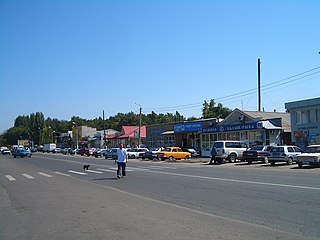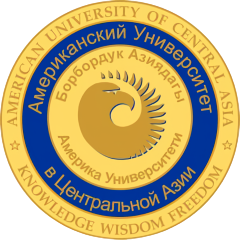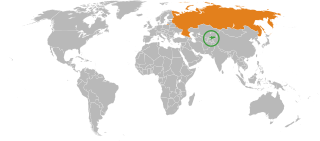Related Research Articles

Bishkek, formerly Pishpek and Frunze, is the capital and largest city of Kyrgyzstan. Bishkek is also the administrative centre of the Chüy Region. The region surrounds the city, although the city itself is not part of the region but rather a region-level unit of Kyrgyzstan. Bishkek is situated near the border with Kazakhstan and has a population of 1,074,075, as of 2021. Bishkek is the primate city of Kyrgyzstan—it is the sole metropolis in the country, and about 17% of all inhabitants of the country live in Bishkek's metropolitan area.

The history of the Kyrgyz people and the land now called Kyrgyzstan goes back more than 3,000 years. Although geographically isolated by its mountainous location, it had an important role as part of the historical Silk Road trade route. Turkic nomads, who trace their ancestry to many Turkic states such as the First and Second Turkic Khaganates, have inhabited the country throughout its history. In the 13th century, Kyrgyzstan was conquered by the Mongols; subsequently it regained independence but was invaded by Kalmyks, Manchus, and Uzbeks. In 1876, it became part of the Russian Empire, remaining in the USSR as the Kirghiz Soviet Socialist Republic after the Russian Revolution. Following Mikhael Gorbachev's democratic reforms in the USSR, in 1990 pro-independence candidate Askar Akayev was elected president of the SSR. On 31 August 1991, Kyrgyzstan declared independence from Moscow, and a democratic government was subsequently established.

The Kyrgyz people are a Turkic ethnic group native to Central Asia. They primarily reside in Kyrgyzstan, Uzbekistan, China, Pakistan and Afghanistan. A Kyrgyz diaspora is also found in Russia, Tajikistan, and Kazakhstan. They speak the Kyrgyz language, which is the official language of Kyrgyzstan.

Kyrgyzstan, officially the Kyrgyz Republic, is a landlocked country in Central Asia, lying in the Tian Shan and Pamir mountain ranges. Bishkek is the capital and largest city of the country. Kyrgyzstan is bordered by Kazakhstan to the north, Uzbekistan to the west, Tajikistan to the south, and China to the east and southeast. Ethnic Kyrgyz make up the majority of the country's 7 million people, followed by significant minorities of Uzbeks and Russians.

The national flag of Kyrgyzstan consists of a red field charged with a yellow sun that contains a depiction of a tunduk, the opening in the center of the roof of a yurt. Adopted in 1992, just over seven months after the country's independence was declared, to replace the flag of the Kirghiz Soviet Socialist Republic (SSR), it has been the flag of the Kyrgyz Republic since that year. The red on the flag is said to be inspired by the pennant lifted by Manas, the country's folk hero.
The term model minority refers to a minority group, defined by factors such as ethnicity, race, or religion, whose members are perceived to be achieving a higher socioeconomic status in comparison to the overall population average. Consequently, these groups are often regarded as a role model or reference group for comparison to external groups (outgroups). This success is typically assessed through metrics including educational attainment, representation within managerial and professional occupations, household income, and various other socioeconomic indicators such as criminal activity and strong family and marital stability. The prominent association of the model minority concept is with Asian Americans within the United States. Additionally, analogous concepts of classism have been observed in numerous European countries, leading to the stereotyping of specific ethnic groups.

Kant is a town in the Chüy Valley of northern Kyrgyzstan, some 20 kilometres (12 mi) east of Bishkek. It is the administrative center of the Ysyk-Ata District. Its population was 22,617 in 2021. Kant was established in 1928.

The American University of Central Asia (AUCA), formerly the Kyrgyz-American School and the American University in Kyrgyzstan, is a liberal arts university located in Bishkek, the capital of the republic of Kyrgyzstan.

Turkish Americans or American Turks are Americans of ethnic Turkish origin. The term "Turkish Americans" can therefore refer to ethnic Turkish immigrants to the United States, as well as their American-born descendants, who originate either from the Ottoman Empire or from post-Ottoman modern nation-states. The majority trace their roots to the Republic of Turkey, however, there are also significant ethnic Turkish communities in the US which descend from the island of Cyprus, the Balkans, North Africa, the Levant and other areas of the former Ottoman Empire. Furthermore, in recent years there has been a significant number of ethnic Turkish people coming to the US from the modern Turkish diaspora, especially from the Turkish Meskhetian diaspora in Eastern Europe and "Euro-Turks" from Central and Western Europe.

The Central Asian Union (CAU), later called the Central Asian Economic Union, was an intergovernmental organization for economic integration between the Central Asian post-Soviet republics of Kazakhstan, Kyrgyzstan and Uzbekistan between 1994 and 2004. Tajikistan joined the Union in 1996 as an observer. Several proposals to restore the Union have been put forward since its dissolution.

Kurds in the United States refers to people born in or residing in the United States of Kurdish origin or those considered to be ethnic Kurds.

Kyrgyzstan–Russia relations are the relations between the two countries, Kyrgyzstan and Russia. Russia has an embassy in Bishkek and a consulate in Osh, and Kyrgyzstan has an embassy in Moscow, a consulate in Ekaterinburg, and a vice-consulate in Novosibirsk.
The history of the Jews in Kyrgyzstan is linked directly to the history of the Bukharan Jews of Uzbekistan. Until the 20th century, most Jews living in the Kyrgyz areas were of the Bukharian Jewish community. However, during the 20th century, large amounts of European Jews began to emigrate to Kyrgyzstan which was then part of the Soviet Union, and a small amount of them still live in the country.

In 1919, the Kara-Kyrgyz Autonomous Oblast was created in Soviet Russia. This was the precursor to the Kirghiz Soviet Socialist Republic which was established in 1936 as republic in its own right within the Union of Soviet Socialist Republics (USSR).

Tyntchtykbek Kadyrmambetovich Tchoroev (Chorotegin) (Kyrgyz: Тынчтыкбек Чороев, is a Kyrgyz historian, publicist and journalist. President of the Kyrgyz History Society, Doctor of History, Professor of the Kyrgyz State National University named after Jusup Balasagyn. Tchoroev is well known as an independent history researcher, Turkologist and journalist. Until September 2011, he worked as a broadcaster at Radio Azattyk, i.e. Kyrgyz Service of Radio Free Europe/Radio Liberty. He was chairman of the Board of the Muras Foundation under the Office of the President of the Kyrgyz Republic.

There is a population of Uyghurs in Kyrgyzstan, who mostly came to the country in three separate migrations throughout the 19th and 20th centuries. According to official statistics, they make up about 0.9% of the national population.
Kazakh Americans are Americans of full or partial Kazakh ancestry. Although in the 1960s the population of Kazakh origin in United States was estimated in 3,000 people, the Census 2000 puts the population size in less of 300 people. According to the American Community Survey in 2010-2012 there were more than 23,000 people born in Kazakhstan, but not all of them are of Kazakh ethnicity.
Uzbek Americans are Americans of Uzbek descent. The community also includes those who have dual American and Uzbek citizenship.
Central Asians in the United States are Americans with ancestry from Central Asia. They include Kazakh, Kyrgyz, Tajik, Turkmen, and Uzbek individuals. People of Afghan, Baloch, and Uyghur descent are also sometimes classified as Central Asians. The United States census does not mention Central Asians under any category.
Central Asians in the United Kingdom are Central Asians living in the United Kingdom. They have been present in the country since the 21st century and primarily originate from the countries Kazakhstan, Kyrgyzstan, Tajikistan, Turkmenistan, and Uzbekistan.
References
- ↑ https://kg.akipress.org/news:2050622
- ↑ "Kyrgyz Communities in the United States: Beyond Myths and Stereotypes". Central Asian Bureau for Analytical Reporting. Retrieved 4 February 2023.
- ↑ "Kyrgyz Families Take Illegal Route Through Mexico In Pursuit Of 'American Dream'". Radio Free Europe / Radio Liberty. Retrieved 4 February 2023.
- ↑ "Kyrgyzstan's Diaspora: An evening of Music and Conversation". Eurasianet. Retrieved 4 February 2023.
- ↑ "Kyrgyz Communities in the United States: Beyond Myths and Stereotypes". Central Asian Bureau for Analytical Reporting. Retrieved 4 February 2023.
- ↑ "Mission". Kyrgyz American Foundation.
- ↑ "Kyrgyz Communities in the United States: Beyond Myths and Stereotypes". Central Asian Bureau for Analytical Reporting.

